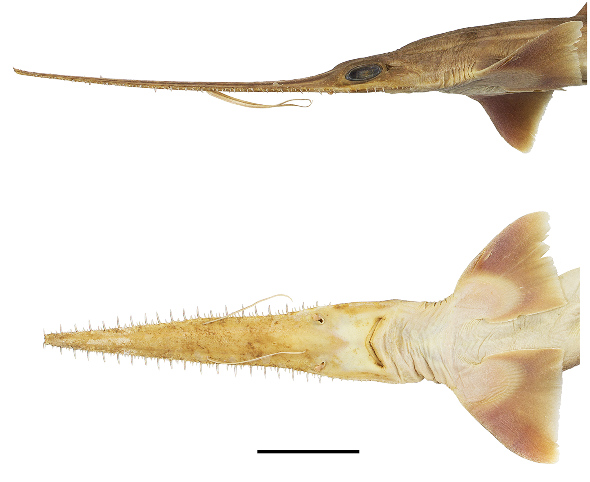Members of the order Pristiophoriformes within the vertebrate subphylum comprise an unusual group of sharks. Collectively known as sawsharks, these marine fishes are distinguishable from other elasmobranchs (sharks, skates, and rays) by a number of unique features. Most notably, sawsharks possess a snout that resembles a long, flat blade. Sawsharks use their sawlike snout—which bears alternate large and small teeth on each side that are weakly embedded and periodically replaced—to slice and kill their prey. Another distinguishing feature of sawsharks is the presence of one pair of long barbels—slender, tactile organs—on the underside of the snout. Recently, scientists discovered two new species of this remarkable type of shark. See also: Pristiophoriformes; Selachii; Shark history

Two genera—Pliotrema and Pristiophorus—make up the order Pristiophoriformes. Members of the Pliotrema have six pairs of gill slits, which is an unusual number for modern sharks because only primitive forms possess more than five gill slits. (The seven species belonging to the genus Pristiophorus have five gill slits.) Previously, the genus Pliotrema was thought to contain only one species: P. warreni. However, marine biologists analyzed specimens from African waters of the western Indian Ocean and identified two additional species of six-gilled sawsharks: P. annae and P. kajae. Specifically, P. annae inhabits coastal waters off Zanzibar, whereas P. kajae populates waters along the western coast of Madagascar. See also: Indian Ocean; Speciation; Species concept
Interestingly, marine investigators did not utilize live or laboratory specimens to make their discovery. Instead, the researchers compared newly obtained photographs of sawsharks—either caught by local fisherfolk or observed by biologists tracking fish off the coast of Africa—with older and misidentified specimens stored at various institutions and museums, including the Natural History Museum in London. By analyzing and measuring anatomical details, as well as employing high-resolution scanning electron microscope techniques, the scientists confirmed the two new species of sawsharks. See also: Scanning electron microscope
As is the case with P. warreni, the two new species are presumed to be relatively rare, having a restricted geographical range and inhabiting ocean bottoms, where they feed on bony fishes, shrimps, and squids. With regard to their conservation status, they likely are threatened species, being susceptible to bycatch (the incidental capture of nontarget species of fish and other marine creatures) by bottom-trawling fishing gear. See also: Biodiversity; Fisheries ecology





